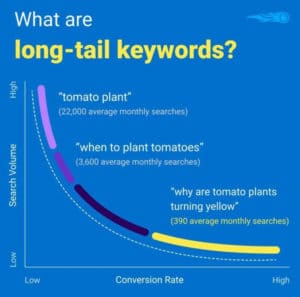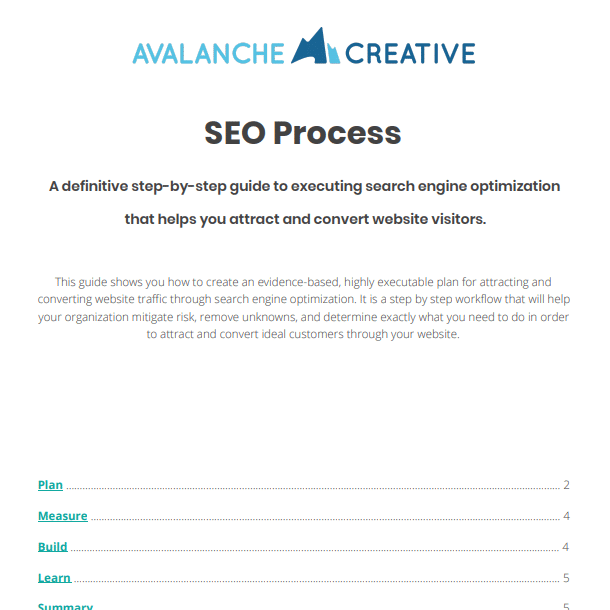Finding Your Topic “Sweet Spot”
Category: Search Engine Optimization | Tags: Content Strategy, SEO, avalanche email, infographic
Learn More and Subscribe to The Avalanche Weekly Email
On Monday SEMRush shared this image and, to put it simply, I fell in love.
I’ve never seen a better visualization of the power of long-tail keywords.
If you need a break down of what this represents, read the bullets below. If not, skip past this for a faster read…
- “tomato plant” is what we call a fat-head keyword. It’s not incredibly descriptive. Imagine someone walking up to you and saying, “tomato plant.” What is it they are looking for? Do they want to know where to get one? How much they are? Where to plant them? you get the idea.
- On the y-axis, we have search volume, which is the number of times per month, on average, over the last 12 months that term gets searched.
- On the x-axis, we have conversion rate, which is the number of actionable goals (form completions, calls, sales, etc.) divided by the total traffic.
- “why are tomato plants turning yellow” is a long-tail keyword. It’s descriptive and you understand the problem someone has; they have yellow tomato plants.
- Typically, the long-tails are more descriptive and therefore the searcher understands their problem. With that, you can more easily offer a solution, which increases the opportunities to convert.
Finding the Topic Sweet Spot
This visualization got me thinking… and now I’m going to make a big claim:
Every organization has a topic sweet spot in which their dominance of that topic(s) in the search engines would benefit the goals of the organization.
For every topic, there are fat-head and long-tail keywords.
Depending on what you sell, there exists a group of keywords somewhere between the fat-heads and the long-tails.
There is a place where volume and conversion rate meet that, if your organization dominated that topic within the search engines, your organization would grow.
So, where do you start?
You start with research.
- Complete comprehensive keyword research where you get a panoramic view of your topics.
- Organize those keywords into topics.
- Use available data like PPC costs, keyword difficulty scores, and more to determine where there might be opportunities.
- Use a tool like SEMRush to determine what you’ll need to compete on the topics (images, video, FAQs section, schema, etc.)
What are your topics? Topics are vast and there’s plenty to talk about. Think of topics in relation to one another…
- Tomato plants are a topic of their own.
- They are a subtopic of tomatoes…
- Which are a subtopic of fruit (yeah, tomatoes are a fruit)…
- Which are a subtopic of food.
You get the idea. Remember that organizing topics well is crucial to your SEO strategy. In fact, if you didn’t know, it’s Google’s mission to organize information:
Share this article:
The Avalanche Email: Fun. Simple. Educational. No Selling.
Learn Result-focused SEO & Content
Join over 2,272+ others who get one email every Wednesday with simple instructions on how to get more website traffic and leads through SEO and content marketing. (Learn more about the email)
Keep Learning
🏔️ Hook, Line, and Sinker 🎣
Use this fishing framework to turn your posts into stories that capture attention, create tension, and inspire action from your audience.
🏔️ Avoid Everything That Doesn’t Move You Forward
Stop chasing shiny tools and refocus on what moves your marketing toward the end zone. Simple steps to cut noise and make steady progress.
🏔️ Stop Tuning the Race Car That Won’t Win a Race
Site speed won’t fix a weak message. Focus on clarity, trust, and real value first. Here’s how to build a website that actually works.
🏔️ Earning Preference > Tracking Visibility
Hi friend, Lance here. Today’s email is about a shift we’re seeing and feeling across marketing teams right now: We’re obsessed with tracking visibility but under-invested in earning preference. 🚨 The Problem Every marketer I talk to wants to know how their brand shows up in AI search, LLMs, and assistants. We’re running to new tools that track…
What’s the Best CMS for Landscaping Businesses?
Compare the best website platforms for landscapers. Learn the pros and cons of Wix, Squarespace, and WordPress, and why WordPress is best for long-term SEO.






